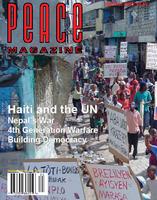
Peace Magazine Apr-Jun 2006, page 22. Some rights reserved.
Search for other articles by Rajan Philips here
Joining the "coalition of the willing" through a special door
The recent agreement between the US and India is intended to open the door to "full civilian nuclear energy co-operation" between the two countries. The agreement would lift the current ban on American nuclear supplies to India provided they are used only for civilian nuclear purposes. In return, India will separate its nuclear energy programs and nuclear weapons programs and subject the former to international supervision.
The sanctions against nuclear supplies to India are the result of its refusal to sign the Non Proliferation Treaty (NPT) and its previous use of nuclear fuel that was supplied for energy purposes, to produce nuclear warheads. In fact, the plutonium for India's first nuclear weapons test in 1974 was produced from the Canadian CIRUS Reactor supplied exclusively for civilian nuclear energy development. India carried out three further tests in 1998.
Altogether 187 countries have signed the NPT, five of them possess nuclear weapons, ten countries started nuclear programs but have now scrapped them, while several others have the technical skills and resources to build nuclear weapons but have chosen not to. India's position has been that it should not be forced into signing the NPT, when it has far fewer weapons (less than 150) than what each of the major nuclear powers had amassed before they signed the treaty; the US had over 6300, Russia over 3200 from the former USSR, China 400, France 350 and the UK 200.
Besides India, there are three other holdout countries on the NPT: Israel (200 weapons), North Korea (less than 15) and Pakistan (75). Iran signed the NPT in 1970, before the Khomeini revolution, but has been surreptitiously trying for the last two decades to achieve nuclear weapons capability. North Korea and Iran are considered by the US to be unstable and unpredictable and therefore dangerous to be left unchecked.
Critics argue that not requiring India to sign the NPT as a condition of resuming nuclear supplies for civilian use will encourage other countries like Iran and North Korea to ignore world opinion and embark on their own nuclear weapons programs. It will also exacerbate the nuclear rivalry between India and Pakistan, while creating unnecessary tension between India and China.
The new agreement will require Congress ratification and new laws to roll back the current regulations barring US supplies to India. But this is not assured given the concerns among both Republicans and Democrats in Congress. To be successful, the agreement also requires the support of the 44-nation Nuclear Suppliers Group that coordinates nuclear technology transactions. Britain, France and Russia -- all wanting to exploit India's huge nuclear market -- are said to be in favour of the deal, while others like Ireland, Japan and Netherlands are not too enthusiastic about it. India is already in negotiations with Russia to obtain supplies for one of its starving nuclear power stations, but the US is not amused by the prospect of Russia rushing supplies to India before the new agreement passes though the US Congress.
India would like to show that it has multiple sources of nuclear supplies, not just the US, to deal with criticism at home that India is joining Bush's coalition of the willing through a special door. A deal with Russia would suit just fine. Thirty five years ago, in 1971, the government of Indira Gandhi signed a 20-year Treaty of Peace, Friendship, and Cooperation with the then Soviet Union. It ran out in 1991, even as the Soviet Union disintegrated that same year. The Cold War ended and the US became the world's sole superpower.
India's military closeness with the US began under Prime Minister Narashimha Rao and the then-US President George H.W. Bush. During the Clinton presidency, the BJP government raised the initial contacts to the level of 'strategic alliance' on the premise that "India is a natural ally of the US". A new 'Framework Agreement on India-US Defense Relations' has been developing under the Bush / Singh administrations, and India became the first country to welcome Bush's National Missile Defense Program, which has alarmed others as a move towards the weaponization of space.
The new agreement emphasizes the "strategic partnership" between the two countries "to meet the global challenges of the 21st century". It is through selective "strategic partnerships" that the Bush Administration is trying to marginalize the United Nations and run the world from the White House. It would be a tragedy if India, having coveted a seat in the Security Council for so long, were to give up on the UN on a note of sour grapes, for an American nuclear handshake.

Peace Magazine Apr-Jun 2006, page 22. Some rights reserved.
Search for other articles by Rajan Philips here